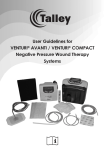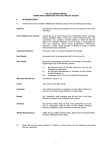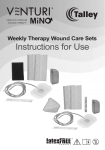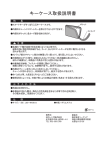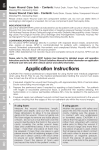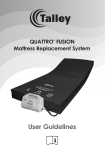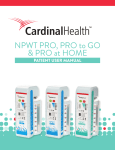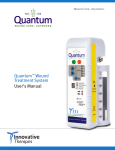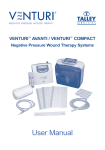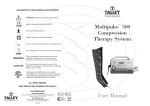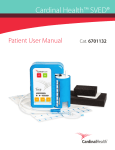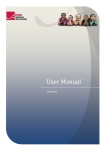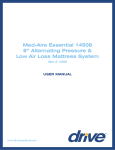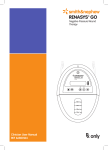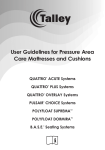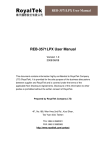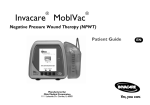Download 3E Venturi MiNO user manual
Transcript
User Guidelines for the VENTURI® MiNO Negative Pressure Wound Therapy System Explanation of Label Symbols and Statements Protect from heat and radioactive sources Caution Refer to instructions of use / booklet Temperature limitation Medical Devices Directive 93/42/EEC Humidity limitation Atmospheric pressure limitation North America ETL listed The Type 19 is suitable for connection to type BF applied parts Class II Equipment (Double Insulated) Do not dispose of with the normal household waste (please refer to www.talleygroup.com for further details) Manufacturer WARNING This is a statement that alerts the user to the possibility of serious injury or other adverse reactions with the use or misuse of the device CAUTION This is a statement that alerts the user to the possibility of a problem with the system associated with its use or misuse Operating Instructions Date of Manufacture Keep dry Fragile, handle with care IP22 IP: Ingress Protection (Pump only) 2: Protection against fingers or other object not greater than 80mm in length and 12mm in diameter 2: Protection from vertically dripping water when tilted to 15o) Note: Abbreviation: Negative Pressure Wound Therapy is abbreviated to ‘NPWT’ throughout this document 1 Contents Explanation of Symbols and Statements Introduction / Intended Use Page 1 2 Contraindications3 List of Components 3 Cautions and Warnings Information 3 How to Apply NPWT 5 User Information 6 Battery Information 6 Care and Maintenance 7 Warning and Fault Indicators 8 Specification9 EMI / EMC Statement EMC Manufacturer’s Declaration 10 Back Cover Introduction / Intended Use Thank you for choosing to use the VENTURI® MiNO Negative Pressure Wound Therapy (NPWT) system from Talley. In doing so you have selected an efficient, competitively priced product for the treatment of many wounds including pressure ulcers, dehisced surgical wounds, diabetic/neuropathic ulcers, venous leg ulcers, post surgical wounds, sinus drainage and management, traumatic wounds and pre- and post-op flaps/grafts. The VENTURI® MiNO NPWT system features a lightweight, versatile vacuum power unit which benefits from dual-power technology, offering a seamless choice of mains or battery operation. The integral battery is charge-optimised, and provides long-lasting power back-up when needed. The battery operation option allows the system to function away from a mains power supply for extended periods of time, allowing the patient full mobility during therapy, if required (a carry case with shoulder/waist strap is supplied). NPWT is applied utilising a choice of VENTURI® MiNO Weekly Therapy Wound Care Sets which include a choice of gauze or foam dressing, a drainage canister, silicone drains and transparent adhesive film. The VENTURI® MiNO NPWT system will benefit from careful installation and use, providing a long and effective service life. Please read and understand this document completely before applying NPWT. 2 CONTRAINDICATIONS Do not place NPWT dressings directly in contact with exposed blood vessels, anastomotic sites, organs or nerves. NPWT is contraindicated for patients with: 1. Malignancy in the wound 2. Untreated osteomyelitis 3. Non-enteric and unexplored fistulas 4. Wounds with difficult haemostasis 5. Necrotic tissue with eschar present NOTE: After debridement of necrotic tissue and complete removal of eschar, NPWT can be used. List of Components Your VENTURI® MiNO NPWT system should comprise the following items - please ensure you have all of these before installation. Note: Wound Care Sets are supplied separately. l VENTURI® MiNO (TG600/14) l 5V Mains adapter FW7662M/05 l Carry bag* * may not be included in all markets WOUND CARE SETS (supplied separately) l Gauze Weekly Therapy Wound Care Set l Foam Weekly Therapy Wound Care Set l Slim Foam Weekly Therapy Wound Care Set ALSO AVAILABLE l 5V Mains adapter FW7662M/05 l Carry bag Cautions and Warnings lThere are no special skills required to operate the pump unit however, Negative Pressure Wound Therapy should only be used under the advice, recommendation and supervision of a licensed Physician and / or a registered nurse. lThe medical professional is responsible for applying his/her best medical judgment when using this system. Prior to use, the medical professional(s) treating the wound must assess how to best use the system for an individual wound. lSelect correct setting for therapy required. Care should be taken not to accidently change pressures once set as the efficiency of the therapy may be reduced. This could also be caused by pets, pests or children. 3 Cautions and Warnings (continued) lThe electricity supply is of the type indicated on the power adapter. lCheck the power adapter lead is free from damage and is positioned so as not to cause an obstruction, or injury, e.g. strangulation. Do not position the vacuum power unit or power adapter such that makes it difficult to disconnect the supply or drain plug. lEnsure the power adapter lead, drain tube or vacuum power unit cannot become trapped or crushed, e.g. via raising or lowering of bed or bed rails or any other moving object. All tubes must be free of kinks, twists, properly connected and positioned so as not to cause an obstruction or injury. lDo not place the vacuum power unit or power adapter on or near a heat source. lNever use the power adapter whilst placed on top of or near to material which is flammable or can be damaged by heat. (The supplied power adapters plug directly into the power source partly mitigating this issue). lThe vacuum power unit must only be used with the approved power adapter supplied by Talley (see Specification on page 9) lThe VENTURI® NPWT system (Vacuum power unit and power adapter) is not used in the presence of flammable anesthetics or in an oxygen enriched environment. lSuitable for continuous use. lNot suitable for sterilisation. lThe materials used in the manufacture of all components of the system comply with the required fire safety regulations. lTalley advice against smoking whilst the system is in use, to prevent the accidental secondary ignition of associated items which may be flammable. lDo not modify any of the medical devices or accessories in any way or use unspecified parts. Do not use unspecified parts. lChoking may result from a child swallowing a small part that has become detached from the ME equipment. lA Weekly Therapy Wound Care Set must be used with the VENTURI® MiNO system to carry out NPWT. lPlease refer to the ‘Instructions for Use’ leaflet supplied with Weekly Therapy Wound Care Set for dressing application and setup. Note that the dressings in the set are sterile and for single patient / single use only, not intended for reuse. lIntended for home healthcare and professional healthcare facility environments. lThe device is intended to be used with its carry bag. lDo not connect to any other medical device or equipment. lThe power unit and power adapter should be cleaned between patient use (refer to Care and Maintenance Section). lThe VENTURI® MiNO vacuum power unit is non-serviceable. lWireless equipment such as mobile phones should be kept at least 10 feet or 3.3m away from this equipment. lThe above warnings, cautions and any safety considerations should be observed on a routine and regular basis, not only upon installation. 4 How to Apply NPWT NB. A Weekly Therapy Wound Care Set must be used with the VENTURI® MiNO system to carry out NPWT (see page 3 for available options). Please refer to the ‘Instructions for Use’ leaflet supplied with Weekly Therapy Wound Care Set for dressing application and setup. CAUTION! The medical professional is responsible for using his/her best medical judgment when using this system. Prior to use, the medical professional(s) treating the wound must assess how to best use the system for an individual wound. 1. Remove all packaging from the power unit and mains adapter. Note: If the battery charge appears to be partially depleted on first use, the power unit should be used with the power adapter, to fully charge the battery during operation. 2.Attach the drainage canister to the VENTURI® MiNO power unit by lining up the two parts, pushing together and twisting to lock (Fig. 1). Ensure canister is correctly located and secured otherwise NO CANISTER alert will appear and power unit will not operate. Fig. 1 3. Prepare and seal wound as described in the Weekly Therapy Wound Care Set ‘Instructions for Use’. 4. Attach the portal drain to the power unit canister by pushing the tubing firmly and fully onto the tubing connector located on the top of the canister. Push the tubing down into the channel to assist with the routing of the tubing. 5. OPERATING THE VACUUM POWER UNIT: a)If using the mains power adapter, insert the smaller end (DC outlet) of the supplied power adapter cable into the side of the VENTURI® MiNO power unit, and the other end into the appropriate power outlet. The power adapter indicator should be illuminated. NB. The battery will charge when the unit is connected to the power source (indicated by the battery charge icon on the top right of the display screen) and provides automatic power back-up if the external power supply or adapter fails. It is recommended to use the power adapter when convenient to do so as this will ensure the battery is fully charged when needed. A fully discharged battery will take a number of hours to fully charge. b) Press RUN/STOP button (Fig. 2) to initialise and run the power unit (operating pressure and battery charge status will be displayed). c) The default operating vacuum is 80mmHg. The vacuum level can be adjusted between a choice of 80mmHg or 120mmHg by pressing Fig. 2 the UP/DOWN arrow button (Fig. 3). NB. The display screen is only illuminated for a short period after button operation in battery mode. Press the RUN/STOP button briefly to illuminate the screen. 6. Once the power unit is running, observe the wound site. The dressing Fig. 3 should contract noticeably, becoming firm to the touch. If the dressing fails to contract, the dressing has not been completely sealed. Reinforce the dressing seal and/or adjust the drain and initiate suction again. 5 How to Apply NPWT (continued) NB. During system set-up, various checks and internal tests take place and if any intervention is required an alert will occur, but not until several minutes after set-up. WARNING: Particularly when used outside of a medical institution, get immediate medical assistance from those responsible for the prescription and setting of the NPWT system should any of the following occur:- obvious bleeding or pain; the wound site or exudate presents unexpected changes in its condition, colour or odour; the wound dressing becomes detached or ineffective; the tubing becomes blocked. 7.To change or remove dressing, switch off power unit (press and hold the RUN/ STOP button until power unit beeps). Clamp the drain tubing and remove by lifting the tubing up from the routing channel and pulling from the tubing connector on the canister. Dispose of used Wound Care Set according to local clinical waste policy. If required, apply new Wound Care Set and continue NPWT. 8.Canisters should be replaced as required or weekly. To change canister, clamp and remove Wound Care Set tubing as above (this can be reconnected to new canister and unclamped if wound dressing is not being changed). Rotate canister to unlock and remove from power unit. Dispose of used canister according to local clinical waste policy. If continuing NPWT, attach new canister and connect Wound Care Set tubing as previously described. 9. To switch off the power unit, press and hold the RUN/STOP button until power unit beeps. 10. Place the user manual in a safe place for future use. User Information Fig. 4 lThe VENTURI® MiNO is supplied with a carry bag which can be worn on the shoulder, across the body or around the waist. When placing the power unit in the carry bag, make sure that it is oriented so that the tubing exits the top of the bag without kinking, bending or straining against the connector port to ensure correct operation. (Fig. 4). lTo ensure correct operation, the VENTURI® MiNO power unit should always be kept in an upright position. The power unit will display and sound an alert if the unit is over tilted (refer to Warning and Fault Indicators on page 8). Battery Information lA fully charged battery should operate the power unit continuously for at least 24 hours. lCharge status is shown on the display of the power unit when it is in operation. lThe power adaptor will display a green light when delivering a charge to the VENTURI® MiNO power unit. lThe battery is not serviceable and cannot be removed, changed or replaced. l Use only the mains adapter supplied with the system. 6 Battery Information (continued) CHARGING THE BATTERY The battery will charge when the unit is connected to the power source, indicated by the battery charge icon on the top right of the display screen, (Fig. 5) (only displayed when the power unit is switched on) and provides automatic power back-up if the external power supply fails. It is recommended to use the power adapter when convenient to do so as this will ensure the battery is fully charged when needed. A daily charge is recommended. A fully discharged battery will take a number of hours to fully charge and can be left to charge overnight. NB. A full charge is indicated by the ‘lightening bolt’ symbol only. 80 -mmHg Fig. 5 Care and Maintenance POWER UNIT Always disconnect the VENTURI® MiNO power unit from the power adapter and the power adapter from the power source before carrying out cleaning. Check all electrical connections and power lead for signs of excessive wear. The power unit / power adapter can be wiped down with detergent or disinfectant solution or wipe*. Do not use solvents. Unsuitable for sterilisation. Dispose of the power unit / power adapter in accordance with the local regulations including WEEE requirements. The power unit / power adapter should be cleaned between patient use as a minimum. SERVICING The VENTURI® MiNO power unit is non-serviceable. Should a fault occur, please refer to the ‘Warning and Fault Indicators’ section on page 8. If the power unit fails to operate correctly please contact Talley. * In line with the MHRA Medical Device Alert (MDA/2013/019), Talley advises customers to use pH neutral, high level disinfectant cleaning products to sanitise reusable medical devices to prevent damage to materials and the degradation of plastic surfaces after prolonged use. The use of inappropriate cleaning and detergent materials on medical equipment could damage surfaces and may compromise the ability to decontaminate medical devices adequately or may interfere with device function. Talley recommends the use of TECcare® CONTROL antimicrobial wipes and fluid to clean and decontaminate all products it supplies to health and social care facilities. TECcare® CONTROL products provide class leading broad spectrum, high level disinfection with an exceptional safety profile. Being pH neutral TECcare® CONTROL can be universally used on all hard and soft surfaces without any detrimental effect. TECcare® CONTROL is CE marked for cleaning medical equipment. WEEKLY THERAPY WOUND CARE SETS Wound Care Sets and canisters are disposable and intended for single use only. After use please dispose of in an appropriate manner in accordance with local regulations and hospital best practice. TRANSPORT AND STORAGE 7 Handle with care. Please report instances of damage or impact to Talley Service Department. Transport –25 °C without relative humidity control; and +70 °C at a relative humidity up to 93 %, non-condensing. An atmospheric pressure range of 700 hPa to 1 060 hPa. Suitable for all standard modes of transport when in the correct packaging. Care and Maintenance (continued) OPERATIONAL CONDITIONS A temperature range of +5 °C to +40 °C; A relative humidity range of 15% to 93%, non-condensing Operational Atmospheric Pressure: 700 hPa to 1060 hPa Suitable for pollution degree 2 Operational altitude ≤ 2 000 m IP Rating: IP22 pump only MANUFACTURER’S GUARANTEE The VENTURI® MiNO power unit is covered by a 12 month manufacturer’s guarantee. The intended design life is 2 years. Warning and Fault Indicators ! Fig. 6 The VENTURI® MiNO power unit features audible and graphic indicators to alert when user intervention is required. Once corrective action has been taken the alert will self-cancel and normal operation will resume. The display screen will toggle between the alert graphic and the instruction to refer to the user manual for more information (Fig. 6). The illuminated display and sounder will persist whilst the alert state is active. Should an alert persist or immediately re-occur, contact Talley. All sounders can be silenced and messages cleared by pressing and holding the RUN/STOP button to switch the power unit off, whilst corrective action is taking place. WARNING INDICATORS NO CANISTER (Fig. 7) – indicates canister is missing or is not correctly fitted. The power unit will fail to operate whilst this message is displayed. Check that canister is correctly located and secured, as detailed on page 5. ! CANISTER FULL (Fig. 8) – indicates that the canister is full and should be removed/replaced, as detailed on page 6. The power unit will cease to run until corrective action has been taken. CONSTRICTED TUBE/LOW FLOW* (Fig. 9) – indicates ! tube blockage/constriction or state of low flow. Check that low flow is not caused by pinched or bent tubing. If exudate is pooling in the wound bed, the dressing should be changed. This alert will self-cancel after 5 minutes and will re-occur if the condition persists. NB. This alert may arise under normal operation if the wound exudate levels are very low. CHECK DRESSING* (Fig. 10) / DISCONNECTED TUBE* (Fig. 11) – indicates vacuum pressure has fallen below minimum allowable levels, due to either a leak in the dressing or a tube disconnection. The power unit will continue to run whilst this message is displayed. Check that wound dressing is completely sealed and that all tubing connections are secure. ! Fig. 7 ! ! Fig. 8 ! ! Fig. 9 8 Warning and Fault Indicators (continued) TILT (Fig. 12) – activates when the power unit is placed at an angle that could affect the canister full indication. The power unit will continue to run whilst this message is displayed. Return the power unit to an upright position. ! ! Fig. 12 LOW BATTERY (Fig. 13) (only ! ? appears during battery operation) Fig. 10 – battery icon at the top left of the normal operation display screen flashes on/off, indicating battery charge is low and battery needs recharging. Plug into a power source to charge. FATAL ERROR (Fig. 14) – the screen displays a letter E followed by a number, indicating an irrepairable fault. This screen should never appear during normal operation but if it does, please contact Talley. + ! ! Fig. 11 80 ! E1 -mmHg Fig. 13 Fig. 14 * the sounder can be silenced temporarily by briefly pressing the UP/DOWN button. Specification POWER UNIT Model Ref: Construction: Dimensions: Weight: DC Input Voltage: Vacuum Application: Vacuum Range: Fixed Internal Battery: Part Number: 150ml CANISTER Construction: Dimensions: POWER ADAPTER Mains Adapter Type: Input: Output: Cable Length: Part Number: VENTURI® MINO Venturi v.II TG600/14 Flame retardant ABS W105mm x D52mm x H112mm 250g 5V Nominal Continuous 80mmHg or 120mmHg (+/- 5mmHg) 3.7V 11.3mAh Lithium Ion - Polymer - Rechargeable Cell CE0120:99-90-22-500 ETL:99-90-22-505 INMETRO:99-90-22-504 Textured ABS (includes absorbant media) W54mm x D52mm x H112mm FW7662M/05 (supplied) 100-240V ~ / 50-60Hz / 700mA 5V DC / 1.1A 3 metres 34-26-05-105 The above mains adapters are considered part of the ME equipment. The VENTURI® MiNO power unit must only be used with the specific external power adapter as supplied by Talley. 9 Talley products are manufactured to comply with International and National safety standards. Talley design and manufacture products to conform to the requirements of ISO9001, ISO13485 and Directive (93/42/EEC). Talley reserves the right to modify the specification of any product without prior notice in line with a policy of continual product development. Our standard terms and conditions apply. EMI/EMC Statement and Manufacturer’s Declaration This equipment has been tested and found to comply with the limits of EN 60601-1-2. These limits are designed to provide reasonable protection against harmful interference in both a medical and residential environment. This equipment generates, uses and can radiate radio frequency energy and, if not used in accordance with manufacturer’s instructions, may cause harmful interference to radio communications. However, there is no guarantee that interference will not occur in a particular installation. If this equipment does cause harmful interference to radio or television reception or other equipment, which can be determined by turning the equipment off and on, the user is encouraged to try to correct the interference by one of the following measures: l Reorient or relocate the receiving antenna. l Increase the separation between the equipment. l Connect the equipment to an outlet on a circuit different from that to which the receiver or equipment was connected. The equipment having been tested to operate within the limits of electromagnetic compatibility. (Immunity to interference from nearby sources radiating radio frequency energy). Sources exceeding these limits may give rise to operation faults. Where possible the system will sense the interference and if it is of short duration transparently take countermeasures whilst operating near normally, or failing this will issue a warning and take measures for the continued safely of the user. Further increased levels of energy may cause the system to stop operating, continuously generate random faults or continuous resets. Try to ascertain the source of the interference by turning nearby or suspect equipment off, and see if the interference effects stop. In any such event the user is encouraged to try to correct the interference by one of the following measures: l Have the interfering equipment repaired or replaced. l Reorient or relocate the interfering equipment. l Increase the separation between the equipment and the possible source of the interference. l Connect the equipment to an outlet on a circuit different from that to which the interfering equipment was connected. Information regarding Electro Magnetic Compatibility (EMC) according to IEC60601-1-2, clause 6.8 With the increased number of electronic devices such as PC’s and mobile telephones, medical devices in use may be susceptible to electromagnetic interference from other devices. The EMC (Electro Magnetic Compatibility) standard IEC60601-1-2 defines the levels of immunity to these electromagnetic interferences. From the other hand, medical devices must not interfere with other devices. IEC60601-12 also defines the maximum levels of emissions for these medical devices. The VENTURI® conforms to this IEC60601-1-2 standard for immunity and emission. Nevertheless, special precautions need to be observed: l l l l The VENTURI® needs to be installed and put into service according to the EMC information below. The VENTURI® is intended for use in the electromagnetic environment specified in the tables below. The user of the VENTURI® should assure that it is used in such environment. In general, although the VENTURI® complies to the EMC standards, it can be affected by portable and mobile RF communications equipment (such as mobile telephones). The VENTURI® should not be used adjacent to or stacked with other equipment. In case adjacent or stacked use is necessary, the VENTURI® should be observed to verify normal operation. Guidance and Manufacturer’s Declaration: Electromagnetic Emissions (IEC 60601-1-2) Emissions Test Compliance Electromagnetic environment - guidance RF emissions CISPR 11 Class B Harmonics emissions 61000-3-2 Class A Voltage fluctuations / flicker emissions 61000-3-3 Complies The VENTURI® systems are suitable for use in all establishments, including domestic establishments and those directly connected to the public low-voltage pump supply network that supplies buildings used for domestic purposes. 10 Guidance and Manufacturer’s Declaration: Electromagnetic Immunity (IEC 60601-1-2) Immunity Test IEC 60601 Test Level Compliance Level Electromagnetic Environment - Guidance Electrostatic discharge (ESD) IEC 61000-4-2 ± 6kV contact ± 8kV air ± 6kV contact ± 8kV air Floors should be wood, concrete or ceramic tile. If floors are covered with synthetic material, the relative humidity should be at least 30%. Electrical fast transient/burst IEC 61000-4-4 ± 2 kV For mains supply lines ± 1kV For input/output lines ± 2 kV For mains supply lines ± 1kV For input/output lines Mains supply quality for the mains adapter should be that of a typical commercial and/or hospital environment. Surge IEC61000-4-5 ± 1kV line(s) to line ± 1kV line(s) to line Mains supply quality for the mains adapter should be that of a typical commercial and/or hospital environment. Voltage dips, short interruptions and voltage variations on mains supply IEC 61000-4-11 <5%Ur (>95%Ur) for 0.5 cycle <5%Ur (>95%Ur) for 0.5 cycle 40%Ur (60% dip in Ur) for 5 cycles 40%Ur (60% dip in Ur) for 5 cycles Mains supply quality for the mains adapter should be that of a typical commercial and/or hospital environment. In the event of a mains interruption the VENTURI® 70%Ur (30% dip in Ur) for 25 cycles 70%Ur (30% dip in Ur) for 25 cycles system will automatically use internal battery power, unless the battery is exhausted. >5%Ur (>95% dip in Ur) for 5 secs >5%Ur (>95% dip in Ur) for 5 secs Mains frequency (50/60Hz) magnetic field IEC61000-4-8 Mains frequency magnetic fields should be at levels characteristic of a typical location in a typical commercial and/or hospital environment. Note: Ur is the A.C. mains voltage prior to application of the test level. 3 A/m 3 A/m Guidance and Manufacturer’s Declaration: Electromagnetic Immunity (IEC 60601-1-2) Immunity Test IEC 60601 Test Level Compliance Level 3 V rms Conducted RF 150 kHz ~ 80 MHz IEC 61000-4-6 3 V rms 3 V/m Radiated RF 80 MHz ~ IEC 61000-4-3 2.5 GHz 3 V/m Electromagnetic Environment - Guidance Portable and mobile RF communications equipment should be used no closer to any part of the VENTURI® including cables, than the recommended separation distance calculated from the equation appropriate to the frequency of the transmitter. Recommend separation distance d = 1.2 √P d = 1.2 √P 80 MHz to 800 MHz d = 2.3 √P 800 MHz to 2.5 GHz where P is the maximum output power rating of the transmitter in watts (W) according to the transmitter manufacturer and d is the recommended separation distance in meters (m). Field strengths from fixed RF transmitters as determined by an electromagnetic site survey,a should be less than the compliance level in each frequency range.b Interference may occur in the vicinity of equipment marked with the following symbol: Note1: At 80 MHz and 800 MHz, the higher frequency range applies. Note2: These guidelines may not apply in all situations. Electromagnetic propagation is affected by absorption and reflection from structures, objects, and people. Field strengths from fixed transmitters, such as base stations for radio (cellular/ cordless) telephones and land mobile radio, AM and FM radio broadcast, and TV broadcast cannot be predicted theoretically with accuracy. To assess the electromagnetic environment due to fixed RF transmitters, an electromagnetic site survey should be considered. If the measured field strength in the location in which the VENTURI® is used exceeds the applicable RF compliance level above, the VENTURI® should be observed to verify normal operation. If abnormal performance is observed, additional measures may be necessary, such as reorienting or relocating the VENTURI®. b Over the frequency range 150 kHz to 80MHz, field strengths should be less than 3 V/m. a Recommended Separation Distance Between Portable and Mobile RF Communications Equipment and the VENTURI® The VENTURI® is intended for use in an electromagnetic environment in which radiated RF disturbances are controlled. The user of the VENTURI® can help prevent electromagnetic interference by maintaining a minimum distance between portable and mobile RF communications equipment (transmitters) and the VENTURI®® as recommended below, according to the maximum output power of the communications equipment. Separation distance according to frequency of transmitter in Meters (m) 150 kHz to 80 MHz d = 1.2 √P 80 MHz to 800 MHz d = 1.2 √P 800 MHz to 2.5GHz d = 2.3 √P 0.01 0.01 0.01 0.01 0.12 0.12 0.12 0.12 0.12 0.12 0.12 0.12 0.23 0.23 0.23 0.23 0.1 0.1 0.1 0.1 For transmitters rated at a maximum output power not listed above, the recommended separation distance d in Meters (m) can be estimated using the equation applicable to the frequency of the transmitter, where P is the maximum output power rating of the transmitter in Watts (W) according to the transmitter manufacturer. Note: At 80MHz and 800MHz, the separation distance for the higher frequency range applies. Note: These guidelines may not apply in all situations. Electromagnetic propagation is affected by absorption and reflection from structures, objects, and people. Output Power of Transmitter in Watts (W) This medical device is compliant with: IEC 60601.1 3rd edition Medical electrical equipment safety and essential performance IEC 60601.1.11 2010 Home healthcare environment USER MANUAL PART NUMBER 50-02-15-112/5D Talley Group Limited Premier Way, Abbey Park Industrial Estate Romsey, Hampshire, SO51 9DQ England TEL: +44(0)1794 503500 FAX: +44(0)1794 503555 EMAIL: [email protected] 01/2015 www.talleygroup.com












